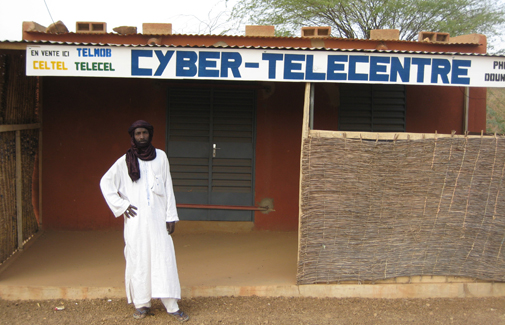Gallery - climate portraits
Hamadou Farka
Place: Tintabora, Oudalan, Burkina Faso, 26 February 2010
Laura Vang Rasmussen and Anette Reenberg
Participant
Hamadou Farka, Born 1960 in Tintabora.
Occupation: farmer and employed at the hospital in Gorom-Gorom
Currently living in Tintabora, small village 2 km from Gorrom-Gorom, the main city in Oudalan Province.
Hamadou Farka expressed clearly his view on the weather this Friday in February. It is very hot, hotter than we are used to. We do not have a thermometer in the village, but we know the temperature.
The changes have come gradually, but it is certainly much warmer now that it was during the time of the big droughts (in the 1970s, for example). We have also noted that there is less water in our wells.
The temperature change affects the crop yields. The cowpeas are not affected much, but the millet yields are much lower because of the higher temperature.
The change in temperature is also causing serious health problems. We have more mosquitoes - we cannot sleep in the open without nets as before, and the kids are suffering a lot from malaria. In addition, we believe, that the increasing problems we have had with measles in the last years are caused by the shift in temperature.
The rains are getting more violent. This is a big problem because our houses are made of clay bricks. They fall apart if the rain comes in concentrated showers with more than 100 mm per day, as we have seen recently.

Erles Ahaya
Place: Gorom-Gorom, Oudalan, Burkina Faso 27 February 2010
Laura Vang Rasmussen and Anette Reenberg 
Participant
Erles Ahaya, Born 1964, Gorom-Gorom
Occupation: farmer and employed at orphans care centre in Gorom-Gorom.
Currently living in Gorom-Gorom, the capital of Oudalan province.
Erles describes the weather this Saturday as windy and warm. This is something the local people observe immediately. They are always observing the weather. He stresses that there is a very direct relation between the wind and the heat.
He has noted that there has been a change towards warmer days and cooler nights recently. This new trend in temperature variations is specifically marked in the valleys towards the north. He dwells also with the fact that the variation of the rainfall during the rainy season has been much more pronounced with heavy showers, often with long interruptions. This makes cultivation difficult because the millet sprouts, but is subsequently killed by lack of water.
The changing weather conditions have also created a number of new health problems. The dust storms cause a lot of cases of coughing, and the insufficient food production weakens the population and makes them more susceptible to deceases such as tuberculosis.
Erles notes, however, that the emergence of new technology has contributed to local people's ability to cope with climate variability. The rapid spread of mobile phones has helped pastoralist to efficiently inform each others about the shifting location of productive grazing areas in the region.

Søren Lyberth
Location: Maniitsoq in Greenland
Climate portrait produced by: Frank Sejersen
Participant
Søren Lyberth
Born 1965
Hotel owner, local entrepreneur and former mayor of Maniitsoq
It is March in Maniitsoq in Western Greenland. The wind and snow dominate the town and Søren is not sure if we can visit the skiing-location outside town on skidoo which we have planned. It is one of the locations that he hopes will make the town more attractive for people coming from the outside. While I take the photo we talk about the town hall just across his hotel. “It is probably the most expensive town hall in Greenland. It was built when fishing for Atlantic cod was good”. It is indeed a mark from a historical period where times were good and the town was humming with activity. But due to a decline in the sea temperature and perhaps overfishing as well the Atlantic cod disappeared and the industry collapsed around 1990. This issue is one we very often return to in our conversations; how the closure of the factory and the movement of businesses to other towns have made the population dwindle and unemployment increase. Fishermen are, however, now witnessing an increase in the Atlantic cod in the sea and fiords outside of town. They find it very promising and ascribe it to a warming sea. Søren comments the prospects in the following way: “I think the Atlantic cod will come again. It comes and goes. This applies to both Atlantic cod and cold water shrimps. When we were kids we were told about climate change. Today, people talk about it so much and as if it is only now that climate change is happening. When I went to school I was told that climate change will happen every 50 years… We were told that it will change every 50 years between cold and warm – it is something you have to prepare yourself for”. Right now, Søren and the rest of town are holding their breath waiting for a decision to be taken by the national government. It is a decision that will change the town dramatically and – people hope – turn bad times to good times. The plan is to use the water from the melting ice cap outside Maniitsoq for hydro electric power that can provide a future aluminum smelter with energy. For Greenland as such this industrial step will potentially make Greenland less economically dependent upon Denmark which it is linked to due to a colonial history. Seen from his point of view, a smelter will boost the dynamics of town, nearly double the number of inhabitants and he has several new projects ready on the drawing table – a new hotel overlooking town among others.

